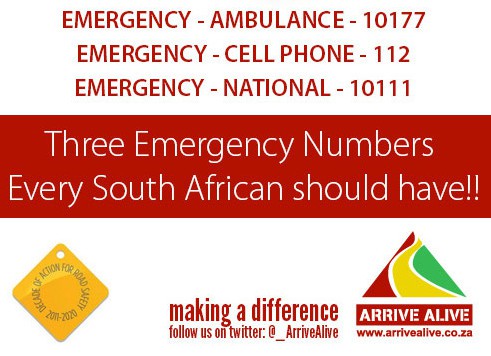South Africa’s confusing emergency numbers
Trying to figure out the best number to dial in a crisis is no easy task
In an emergency in the US you dial 911, in the UK 999, in Europe 112. It’s a free call from any landline or mobile phone. The operators then direct the caller to the best emergency service.
The situation in South Africa is, to put it mildly, confusing. There are at least three emergency numbers to choose from when in a life- threatening situation: 10111, 1017, and 112. In Cape Town you can also call 107 from a landline. Additionally, The Western Cape Government lists 20 different important contact numbers on its website that it advises you “to keep on your fridge or next to the telephone in case of an emergency.”
Why are there are so many different emergency numbers? What happens if you’re in a dire situation and call the wrong number? And why is calling 10111, arguably the most well known emergency number, not free from a cellphone?
It has taken GroundUp days to get answers. We spoke to at least six different people, wrote multiple emails, and hit dead-end upon dead-end.
The only reply we got was from the City of Cape Town. It recommends calling 107 from a Telkom landline in any emergency or 021 480 7700 from a cellphone. There is multilingual support that connects you to the most relevant call centre. However, it isn’t free to call from a cell phone. City employees we spoke to seemed keen for the 107 number to become standard across the country and toll-free from all phones (including mobile), but based on GroundUp’s experience there is simply a lack of co-ordination between the various emergency services.
Police send us on a runaround
We first called the South African Police Service (SAPS) office in Cape Town looking for answers. We were redirected to the SAPS Western Cape Media Centre in Cape Town who asked us to send questions via email. In response to the email, the SAPS Western Cape Media Centre asked us to forward the questions to the SAPS National Media Centre. We got no confirmation that the email was received, so we called back the SAPS Western Cape Media Centre asking for contact details for the SAPS National Media Centre to check if the email was received. Captain FC Van Wyk, the person we spoke with, said he didn’t know a number and couldn’t help.
We then went online to try and track down someone in SAPS who could help us. Upon seeing that the section head position for media relations was vacant, we called the spokesperson, Brigadier Mashadi Selepe. The spokesperson asked what email address the questions were sent to and in response to hearing the email address given to us by Van Wyk, said that was the wrong email address. We then forwarded the email to the address provided by Selepe. After still not receiving a response, we called back Selepe who said they did not have the ability to see if the email was received and advised calling Colonel Amelia Dreyer. Dreyer said to call Brigadier Vishnu Naidoo, the section head of operational services. Naidoo said the best person to help would be Dreyer. We called back Dreyer who asked us to forward the email to her and Naidoo. We received no response that day.
The next day we asked Dreyer when we could expect a response. She said that Naidoo would be the best person to ask as his office was following up on the inquiry. We called Naidoo who responded by saying to “have some patience” because SAPS is a big organisation. He had heard that we were “emailing and Whatsapping” Dreyer a lot. He then hung up.
The following day we messaged Dreyer to check on the status of the enquiry. She apologised and said that she was under the impression that Naidoo had given us feedback already. She said she would contact them again.
The next day there was still no response. We asked Dreyer if we should phone Naidoo again. She said she resent the request and asked them by phone to respond right away. They did not respond. We then went back to Dreyer and said we were giving them until noon to respond. They did not respond.
It seems that the most reliable method to know what number to use is to check online. Other than that, you need to save the numbers on your phone, and memorise which is appropriate for the situation you’re in. We still don’t know why calling 10111 isn’t free from a cell phone.
Support independent journalism
Donate using Payfast

Don't miss out on the latest news
We respect your privacy, and promise we won't spam you.
Next: Toilets for busy taxi rank after many years
Previous: Khayelitsha residents build “speed bumps” after man killed by speeding taxi
© 2017 GroundUp. 
This article is licensed under a Creative Commons Attribution-NoDerivatives 4.0 International License.
You may republish this article, so long as you credit the authors and GroundUp, and do not change the text. Please include a link back to the original article.

